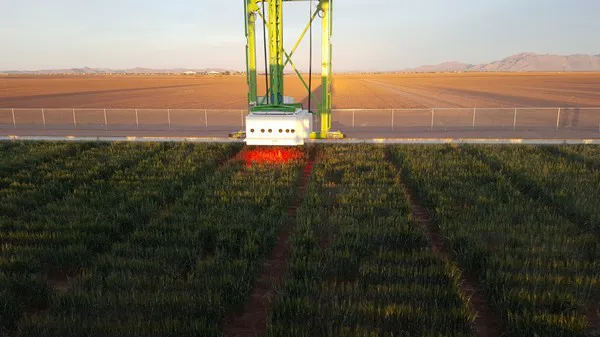In the race to develop new technologies and methods to support sustainable agriculture and imperiled ecosystems, scientists hope to bring an important voice to the conversation: the plants themselves. A $25 million grant from the National Science Foundation will allow researchers from the University of Arizona, Cornell University, the Boyce Thompson Institute, and the University of Illinois Urbana-Champaign to do so through the newly established Center for Research on Programmable Plant Systems.
"Plants are sending us signals and they're telling us things," said Rebecca Mosher, the lead investigator on the project at UArizona and an associate professor in the School of Plant Sciences. "Can we better interpret those signals to understand what they are doing and what they need?"
Through the NSF Science and Technology Center grant, UArizona will receive $3.5 million over the next five years to leverage expertise in molecular plant biology, data analytics to help plants report their experiences digitally in real-time, and remote sensing technology, such as the robotic field scanner at the university's Maricopa Agricultural Center.

The Internet of Living Things
The concept of the Internet of Things is not new. In fact, consumers have already integrated the technology into their daily lives, Mosher explained.
"Newer appliances like thermostats, refrigerators, and even microwaves are designed with built-in sensors that we can connect to our phones, allowing us to check in on things at home or even turn off the air conditioner or the lights from half a country away," said Mosher, a member of the university's BIO5 Institute. "We want to apply that concept and technology to living plant systems."
Remote sensing technologies have been used in agriculture since the 1950s. Drones, sensor probes, and advanced imaging can help farmers identify plots in their fields in need of more nutrients or water and even detect pathogens threatening crops. The Internet of Living Things would harness existing technology and develop new methods of sensing plants' needs on a larger biological scale.
"We have engineers on the project who will work to create new technologies to collect this data," Mosher said. "Imagine robots that can swim in the soil to look at the roots or drone technology that can capture hyper-spectral imaging – those wavelengths that we can't see."
To manage and translate the massive amounts of sensor data produced by these devices, the team will rely on the computational infrastructure and complex analysis expertise provided by CyVerse, a UArizona-led open science workspace for collaborative data-driven discovery.
"The Internet of Things is a hallmark of the Fourth Industrial Revolution, which has been a key focus area for the university," said University of Arizona President Robert C. Robbins. "The work Dr. Mosher and her team are doing is not only fascinating but also has the potential to solve critical challenges like how to make agriculture more sustainable and other pressing concerns faced by farmers across the world."
Crops for the future
The information gathered can help researchers not only better understand how plants interact with their environments but develop new techniques for breeding crops to meet the challenges of a changing global climate.
"This project represents a fundamental shift in how biologists study plants," said Duke Pauli, an assistant professor in the School of Plant Sciences. "For the first time, we will be able to communicate with plants, enabling us to explore how they respond to dynamic environments in which they did not evolve and potentially breed new plants for our changing environment."
As a molecular biologist, Mosher is most excited about the prospect of engineering new pathways for plants to communicate with their human counterparts. "We want to develop systems to better understand what plants are telling us in their own language, for example, 'This growth pattern means I'd like more nitrogen, please,'" Mosher said.
Other UArizona investigators on the project include molecular biologists Jesse Woodson, Mark Beilstein, and Judith Brown from the School of Plant Sciences, as well as Nirav Merchant, director of the Data Science Institute.
"If our research is going to make a transformative impact, whether it's mitigating climate change or creating the bioscience jobs of the future, we have to harness the complex networks of genes, proteins and other biomolecules at work and the nonlinear opportunities they present," said Shane Burgess, vice president of the Division of Agriculture, Life and Veterinary Sciences, and Cooperative Extension. "This team is opening the door to understanding the intricacies of plant systems and applying that knowledge to the challenges ahead."
For more information:
University of Arizona
[email protected]
www.ceac.arizona.edu
